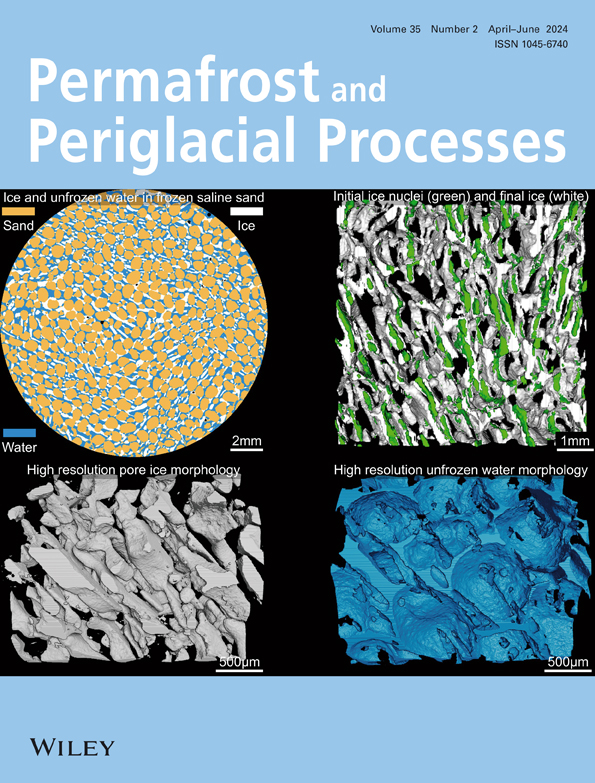Nunavik(魁北克北部)的热收缩裂缝多边形:多边形图案地面的分布和发展
IF 3.3
3区 地球科学
Q2 GEOGRAPHY, PHYSICAL
引用次数: 1
摘要
我们评估了库区北部44万平方公里的Nunavik地区的热收缩裂缝多边形(TCCP)网络的空间分布和形态变异。Nunavik地区跨越了从不连续到连续的永久冻土向北过渡。从80,737张地理参考的高分辨率航空照片和264,504 km2的ESRI卫星底图中,对4,567个TCCP站点进行了采样和分析。对于每个站点,盘点了六个参数并将其汇编成数据库:(a)网络几何排列;(b)交角;(c)细分和嵌套多边形的数目(称为发展的世代);(d)优势多边形形态;(e)地表地质;(f)植被覆盖。表格数据的统计分析揭示了全新世冰川、冰川河流、河流、海洋和有机地貌与网络中不同相交角度之间的强烈关联,为了解热收缩裂缝过程如何在不同的永久冻土景观中发挥作用和表现地貌提供了深入的见解。正交多边形(交角为90°)在平坦地形上占主导地位,其中热机械应力可能在空间上是均匀的。六角形(120°角)和结构不佳的多边形往往形成于地形变化可能产生不均匀热流模式和地面热机械应力的地方,导致不规则的裂缝模式。本文章由计算机程序翻译,如有差异,请以英文原文为准。
Thermal contraction crack polygons in Nunavik (northern Quebec): Distribution and development of polygonal patterned ground
We evaluated the spatial distribution and morphological variability of thermal contraction crack polygon (TCCP) networks across Nunavik, a 440,000‐km2 region of northern Québec that spans the northward transition from discontinuous to continuous permafrost. A population of 4,567 TCCP sites was sampled and analyzed from 80,737 georeferenced high‐resolution aerial photographs and 264,504 km2 of ESRI satellite basemaps. For each site, six parameters were inventoried and compiled into a database: (a) network geometric arrangement; (b) intersection angles; (c) number of subdivisions and nested polygons (referred to as generations of development); (d) dominant polygon morphology; (e) surficial geology; and (f) vegetation cover. Statistical analyses of the tabulated data revealed a strong association between Holocene glacial, glacio‐fluvial, fluvial, marine, and organic landforms and the different intersections angles in the networks, providing insight into how the processes of thermal contraction cracking function and manifest geomorphically across varied permafrost landscapes. Orthogonal polygons (intersection angle of 90°) dominate on flat terrains where the thermo‐mechanical stresses are probably spatially homogeneous. Hexagonal (angles of 120°) and poorly structured polygons tend to form where topography variability probably generates heterogeneous heat flow patterns and thermo‐mechanical stresses in the ground, resulting in irregular cracking patterns.
求助全文
通过发布文献求助,成功后即可免费获取论文全文。
去求助
来源期刊
CiteScore
9.70
自引率
8.00%
发文量
43
审稿时长
>12 weeks
期刊介绍:
Permafrost and Periglacial Processes is an international journal dedicated to the rapid publication of scientific and technical papers concerned with earth surface cryogenic processes, landforms and sediments present in a variety of (Sub) Arctic, Antarctic and High Mountain environments. It provides an efficient vehicle of communication amongst those with an interest in the cold, non-glacial geosciences. The focus is on (1) original research based on geomorphological, hydrological, sedimentological, geotechnical and engineering aspects of these areas and (2) original research carried out upon relict features where the objective has been to reconstruct the nature of the processes and/or palaeoenvironments which gave rise to these features, as opposed to purely stratigraphical considerations. The journal also publishes short communications, reviews, discussions and book reviews. The high scientific standard, interdisciplinary character and worldwide representation of PPP are maintained by regional editorial support and a rigorous refereeing system.

 求助内容:
求助内容: 应助结果提醒方式:
应助结果提醒方式:


